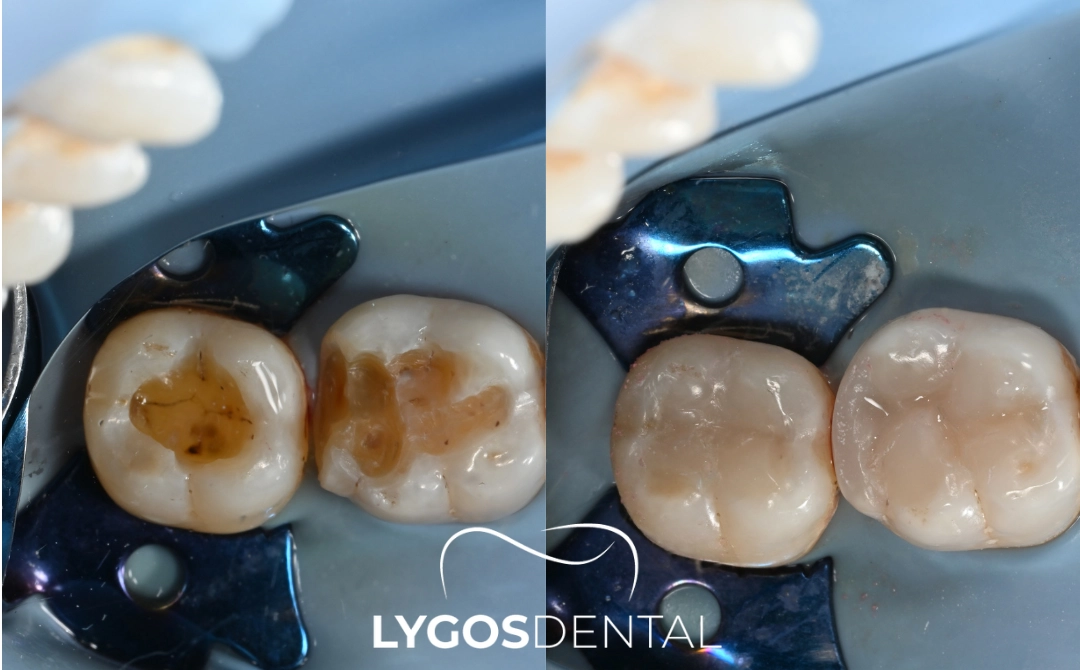Night Toothache Relief: Easy Drug-Free Solutions That Actually Help
So, how does tooth loss affect speech? In this article, we will examine in detail the effects of tooth loss…
There are different materials for dental fillings, each having unique properties and purposes. Dentists select the most suitable material according to the cavity's size, its location, and the patient's cosmetic preferences. Fillings are not just about restoring function; they also maintain the tooth's natural appearance, making it difficult to notice that a tooth has been treated.
Choose Your Topics
The dentist starts by inspecting the affected tooth and may utilize X-rays to obtain a detailed view of the severity of the decay or damage. X-rays help the dentist determine the exact size and depth of the cavity, ensuring the correct treatment plan is chosen.
Following the tooth examination, the dentist applies local anesthesia to numb the area, ensuring the patient stays comfortable and free from pain during the procedure. The numbing effect usually takes a few minutes to set in, and most patients experience only minor pressure during the treatment.
The dentist employs a dental drill or laser to eliminate the decayed sections of the tooth. This vital step prevents the further progression of decay. Afterward, the area is meticulously cleaned to eliminate any bacteria or debris, creating a smooth surface for the filling material.
Once the area has been thoroughly cleaned, the selected material is used to fill the cavity. Composite resin is commonly used for its aesthetic properties, as it can match the tooth’s color. For larger fillings, amalgam or gold might be preferred due to their durability.
After the filling material is applied, the dentist shapes it to align with the tooth's natural form. The filling is then polished to ensure it blends well with the surrounding teeth and does not disrupt the patient's bite.
After polishing, the dentist may ask the patient to bite down to check for any high spots or irregularities. If needed, additional adjustments are made to guarantee a comfortable and natural fit.
A dental filling is often necessary to address cavities, which develop when plaque accumulates on the teeth, generating acids that wear away the enamel. If not treated, these cavities can enlarge and penetrate the inner pulp, possibly resulting in infections.
Additionally, chipped or broken teeth caused by trauma or accidents can be repaired using a filling. This helps to restore the tooth’s natural look and structural integrity, while also safeguarding it against further harm. Fillings are also useful for worn teeth, which can occur due to grinding (bruxism) or the consumption of acidic foods.
By restoring the tooth’s shape and function, fillings prevent additional wear. Moreover, if a patient experiences sensitivity to hot or cold, it may indicate enamel erosion or small cracks in the tooth. In such cases, a filling can help seal these areas, reducing sensitivity and protecting the tooth from further harm.

These consist of a blend of metals, including silver, mercury, copper, and tin. Known for their durability, these fillings can endure the forces of chewing, making them especially ideal for molars. However, due to their metallic look, they are typically not used for anterior teeth. While amalgam fillings are often more cost-effective and have a long lifespan, they lack the aesthetic appeal of other filling options.
Composite fillings are formulated from a combination of plastic and finely milled glass particles. They are favored for their ability to match the natural color of the tooth, making them a great option for visible areas such as the front teeth. While composite fillings may not be as robust as amalgam fillings, they can endure for several years with adequate maintenance. In addition, they involve minimal removal of the tooth structure during the preparation phase.
UnCeramic fillings, typically crafted from porcelain, offer a robust and visually appealing choice.They are highly resistant to discoloration and can remain effective for as long as 15 years. However, ceramic fillings tend to be more costly than composite or amalgam fillings and may necessitate multiple appointments for placement.
Gold fillings represent one of the most long-lasting solutions, with a lifespan extending to 20 years or even longer. Crafted with precision in a dental lab, these fillings are securely bonded to the tooth for optimal durability. Although gold fillings are long-lasting and well-tolerated by gum tissue, they are more expensive and not as aesthetically appealing for visible areas.
Glass ionomer fillings are commonly used for areas below the gumline or in children’s teeth. They emit fluoride, providing an additional layer of defense against future decay. However, they are less durable and not as visually appealing as composite fillings, making them suitable primarily for smaller cavities.

A filling can become faulty for several reasons, such as wear, improper placement, or damage over time. When a filling is defective, it can permit bacteria to infiltrate the space between the tooth and the filling, resulting in decay beneath the filling.
Indications of a faulty filling include sensitivity to hot or cold, pain while chewing, or the presence of visible cracks or gaps around the filling. If a faulty filling is not addressed promptly, it can result in more extensive damage, potentially requiring a crown or root canal treatment.
When the pulp of a tooth becomes infected or inflamed due to significant decay or injury, a root canal treatment might be required. In this procedure, the dentist extracts the infected pulp and fills the tooth with a specialized material to avert further infection.
Unlike standard dental fillings, this type of filling addresses the entire tooth structure, from the crown down to the root. Typically, root canal fillings are followed by the placement of a crown to safeguard the tooth against fracture.

Cosmetic fillings are a type of composite filling used primarily for aesthetic purposes. Patients frequently select them when seeking a restoration that closely resembles their natural teeth and is virtually unnoticeable. Cosmetic fillings are used for front teeth, chips, or cracks, where appearance is crucial. In addition to restoring function, cosmetic fillings improve the smile’s overall appearance, enhancing the patient’s confidence.

Before getting a dental filling, patients may experience discomfort, sensitivity, or visible decay. In certain instances, there may be no obvious symptoms, but X-rays can show the level of damage present.After the filling procedure, most patients experience relief from sensitivity or pain and a restored ability to chew without discomfort.
The tooth’s appearance is also improved, especially when a composite or cosmetic filling is used. Patients should follow proper oral hygiene practices, such as brushing twice a day, flossing, and regular dental check-ups, to ensure their filling lasts as long as possible.
The healing process following a dental filling is generally uncomplicated. Most patients can return to their regular activities right away, although the numbing effect from the anesthesia may persist for a few hours. It’s recommended to refrain from eating until the numbness subsides to avoid accidentally biting the cheeks or tongue.
Some patients might feel slight sensitivity to hot or cold for a few days, but this typically diminishes over time. Over-the-counter pain medications can help relieve any discomfort you may feel. In rare cases, a filling may be too high, causing discomfort when chewing, and a follow-up visit may be needed to adjust the bite.

Receiving a dental filling usually takes around 20 to 60 minutes. Small cavities can be filled in about 20 minutes, while larger or more complex cases may take closer to an hour. Composite fillings, which involve a layering process, may take slightly longer to complete than amalgam fillings.
Generally, 2 to 4 fillings can be done in one appointment, depending on the size and positioning of the cavities. If necessary, a dentist may recommend multiple sessions for patient comfort or if a larger number of fillings is needed.
Yes, it is advisable to brush your teeth after getting a filling. It is advisable to utilize a soft-bristled toothbrush combined with fluoride toothpaste to gently clean the area that has been filled. Just be cautious right after the procedure if the area is still numb.
If a tooth is severely decayed but hasn’t reached the pulp, a filling might still be possible. In instances of more extensive decay, a root canal or crown might be required to restore the tooth's functionality and prevent further harm.
So, how does tooth loss affect speech? In this article, we will examine in detail the effects of tooth loss…
So, how does tooth loss affect speech? In this article, we will examine in detail the effects of tooth loss…
So, how does tooth loss affect speech? In this article, we will examine in detail the effects of tooth loss…

Special Note:
Our treatments are provided by healthcare facilities that possess a health tourism authorization certificate

Special Note: Our treatments are provided by healthcare facilities that possess a health tourism authorization certificate
Selenium Retro, Ataköy 7-8-9-10. Kısım, D-100 Güney Yanyolu No:18/A, 34158 Bakırköy/İstanbul
© 2025, LYGOS DENTAL. All Rights Reserved.